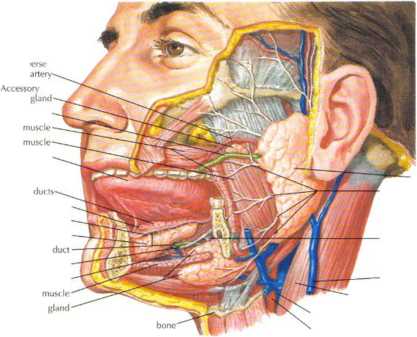netter146

L
GASTROINTESTINAL PHYSIOLOGY Salivary Gland Structure

Submandibular ganglion
parotid ftirotid duci Buccinator Masseter
farotid gland Branches of facial nervo
Fxternal jugular vein Sternodeidomastoid musclc Intornal jugular vein Exłernal carotid artery
Tongue Subiingual plica wilh openings of minor subiingual Subiingual caruncle Major subiingual duet Subiingual gland Submandibular
Lingual nerve Subiingual artery Mylohyoid Submandibular
Hyoid

Figurę 7.24 Salivary Gland Structure_
The salivary glands serve several functions. induding keeping the orał cavity moist and lubricated to protect it from abrasion, controlling orał bacteria by secreting lysozyme, liquetying the łood (thereby allowing mołecules within the food to interact with and stimulate the taste budsj, seaeting r ak ium and phosphate for tooth formation and maintenance, and secreting amylase to begin digestion of starches. The serous acinar cdls secrete the protein and enzymatic compo-nents ol saliva, whereas the mucous acinar cells secrete a watery (low-mucin) mucus. The parotid gland is composed entirely of serous acini. The subiingual gland contains predominateły mucous acim, witr some serous acini as well. Tlie submandibular gland contains a mix-ture of serous and mucous acini. Lingual lipase (secreated by von Ebner's serous glands ol the tonguet mixes with the saliva and begms the digestion of fats.
164
Wyszukiwarka
Podobne podstrony:
netter140 GASTROINTESTINAL PHYSIOLOGY Smali Intestinc Structure: III Mitochondria Tight junctions ■
41783 netter168 Thyroid Gland: StructureENDOCRINE PHYSIOLOGY Hyoid bonę Lymph node Phrenic nerve Sup
67876 netter171 ENDOCRINE PHYSIOLOGYAdrenal Gland: Structure Inferior phrenic arteries Esophagus Lef
59840 netter71 CARDIOVASCULAR PHYSIOLOCY Short-Term Regulation of Blood Pressure 2/3t „NE Ganglion-
10723 netter177 ENDOCRINE PHYSIOLOGY Adrenal Medulla CH/-CH-COOH ganglia CH7-CH2-N
39397 netter147 Salivary Gland Sccretion Aud/tor ^buchKtimuR T.iŃte I from tę —► «2o &n
więcej podobnych podstron